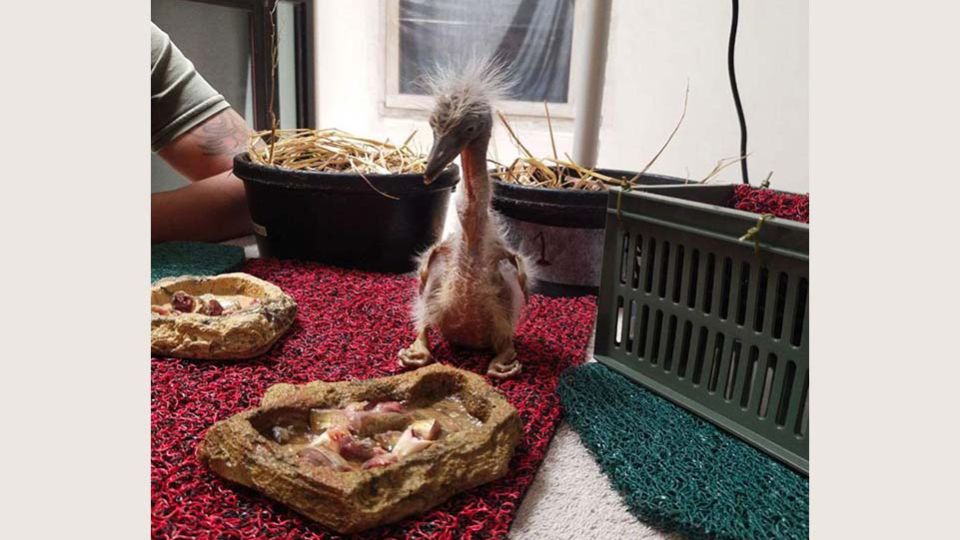May 16, 2025
THIMPHU – Bhutan’s only—and the world’s first—captive breeding centre for the critically endangered white-bellied heron (WBH) is making quiet progress in its efforts to protect one of the world’s rarest birds.
Located in Chachey Dovan along the Thimphu-Gelephu highway, the White-bellied Heron Conservation Centre (WBHCC), is currently home to five herons rescued from the wild, each bird playing a vital role in preserving a species with fewer than 60 individuals left globally.
Bhutan, which is home to nearly half that number, is leading conservation efforts for this elusive riverine bird.
The latest addition to the centre is a female WBH rescued from Kisonachhu, Pinsa, in April 2024. The Royal Society for Protection of Nature (RSPN), which leads WBH conservation in Bhutan, has monitored nesting activity in the area for several years. Despite eggs being laid and hatched, no chicks had previously survived to adulthood.
In 2019, three eggs were laid in the nest at Kisonachhu, but none survived. Last year, a chick, about a week old, was lifted from the same nesting site and brought to WBHCC. Of the chicks hatched that season, one died in the wild while the surviving chick was transferred to the centre.
During this year’s annual population survey, the RSPN team again recorded two chicks at the same nesting site.
A month earlier, in March 2024, WBHCC achieved a major breakthrough, with the first successful hatching of a WBH chick from an egg incubated at the centre. The egg had been lifted from a nest in Tshaidang, Zhemgang, another RSPN-monitored site known for repeated nesting failures.
Over the years, no successful hatching had been recorded there due to frequent disturbances, mostly by monkey predation.
Estimated to be 10–12 days old, the egg was carefully retrieved with the help of a local climber from a tree about 20 to 30 metres tall. It was placed in a portable incubator and transported to the centre.
RSPN team with remote technical guidance from experts in Japan and the Czech Republic, the egg was successfully incubated, and the chick hatched after about 20 days.
“Incubation is relatively straightforward,” Jigme Tshering, chief of the Species Conservation Division with RSPN said. . “The real challenge begins after hatching. In the wild, the mother shapes the nest for the chick’s development. Replicating that artificially requires careful attention.”
At the centre, a human-constructed nest was used to support the chick’s early development. A puppet resembling an adult WBH was used to feed the chick in order to avoid human imprinting. The fragile post-hatching phase was carefully managed, and the chick now more than a year old is growing well.
Another heron, a male, was rescued in 2022 from Phibsoo Wildlife Sanctuary after it became entangled in a fishing net. The remaining two birds, a male and a female, were collected as pre-fledged juveniles from a nest in Rilangthang in 2021 and transferred to the WBHCC.
All five birds now form the founding stock of the centre’s captive breeding programme.
According to Jigme Tshering, captive breeding is considered a last resort in conservation and is only employed when the species’ survival in the wild is no longer viable.
“The centre’s main objective is to establish an ex-situ breeding gene pool,” he said. “This allows us to protect the species outside its natural habitat with the goal of eventually supplementing the wild population.”
Of the less than 60 WBH worldwide, Bhutan accounts for 29 individuals as per this year’s population survey.
Experts have warned that the species could become extinct by 2050 if no intervention is made. The WBHCC’s role is therefore critical to its long-term survival.
The facility houses seven aviaries with circular tops, enclosed by vertical wire and green netting. Each aviary contains a pond filled with fingerlings and is surrounded by vegetation to simulate a natural riverine habitat. Artificial nests are placed to encourage natural breeding behaviour.
Maintaining the birds in captivity poses logistical and financial challenges. The WBHs feed exclusively on fish, and their sensitive nature demands minimal human disturbance.
“Right now, all five are still in the growing phase,” Jigme Tshering said. “We are hoping for natural breeding, but if that does not happen, artificial insemination will be considered to ensure population growth.”
To preserve genetic diversity, herons from different locations—Zhemgang, Kisonachhu, Phibsoo, and Rilangthang—were selected. In a population this small, inbreeding is a serious concern. Tissue and blood samples have also been sent to the National Biodiversity Centre for long-term preservation.
In addition to breeding, the centre serves as a research hub, an educational space, and a global information repository for the species.
“The WBHs are extremely sensitive to environmental changes and human disturbances,” Jigme Tshering said. “This centre offers a secure and controlled environment where the species can recover.”
In the future, the birds raised at WBHCC will be released into safe and suitable habitat.


